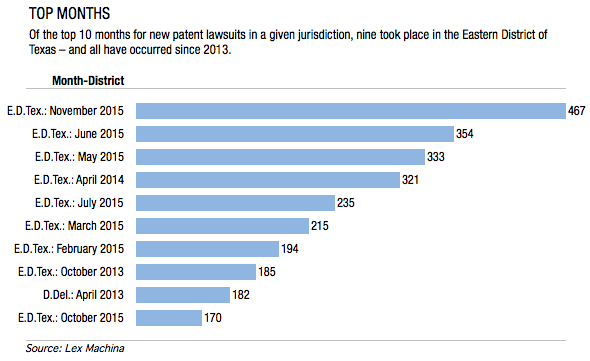© 2015 The Texas Lawbook.
By Jeff Bounds and Mark Curriden
(Dec. 9) – Businesses and individuals filed a record 851 patent infringement lawsuits in November – more than half of them in the federal courts of East Texas – amid concerns that new court rules that went into effect Dec. 1 could make it more difficult for their litigation to be successful.
Lawyers filed 467 new patent cases last month in the U.S. District Court of the Eastern District of Texas, which is 32 percent more infringement lawsuits that have ever been filed in a single month in one judicial district in U.S. history, according to legal-research provider Lex Machina.
The biggest wave of new intellectual property disputes occurred during the five business days surrounding Thanksgiving (Nov. 22-30), when plaintiffs filed 341 suits in East Texas, making it the busiest nine-day period in any court jurisdiction ever, Lex Machina data shows.
The litigation blitz, which solidifies the Tyler-based Eastern District of Texas as the patent litigation capital of America, was sparked by a change to the Federal Rules of Civil Procedure approved by the Supreme Court of the United States that requires plaintiffs to provide more extensive details in their initial complaints regarding alleged wrongdoing by the defendants.
Legal experts say patent owners rushed to file new cases before the new rule took effect Dec. 1 because they are not sure if trial courts will interpret the new requirement in a way that could have cases dismissed early in the legal process.
“It’s really fear of the unknown,” said Jon Hyland, a partner in the Dallas office of Barnes & Thornburg.
Other lawyers agree.
“The rush of filings was simply lawyers not really knowing what the impact of these rule changes will be and trying to be safe rather than sorry later,” said Eric Chenoweth, a partner who specializes in patent litigation at Yetter Coleman in Houston.
“There are a lot of uncertainties about how this rule change will be viewed and implemented by the federal judges,” Chenoweth said. “For example, we have no idea whether the rule will be applied retroactively to cases already pending.”
The 467 new patent cases in November in East Texas greatly eclipses the previous record of 354 lawsuits filed in the Eastern District in June, which in turn exceeded the prior record of 333 from May, according to Lex Machina.

Roughly 55 percent of the record 851 patent lawsuits filed nationwide in November went to the Eastern District, Lex Machina data shows. The U.S. set its previous high water mark in April 2014, when 684 infringement lawsuits were filed, with nearly 47 percent of those in the Eastern District, Lex Machina numbers show.
A group of 22 high volume plaintiffs – defined as patent owners that bring 10 or more infringement suits – were the primary reason for the November surge.
This group accounted for nearly half of all of November’s new infringement litigation. They chose the Eastern District for more than 75 percent of their litigation last month, according to Lex Machina, which is being acquired by LexisNexis Group.

In other words, roughly 37 percent of the United States’ new infringement suits in November were lodged in the Eastern District by one of these frequent-filers.
Although the U.S. Supreme Court approved the change to the federal rules in April, the Eastern District did not see the rush begin until the week beginning Nov. 22, nine calendar days before the new requirement went into effect, Lex Machina data shows.
John Low, a partner who specializes in patent litigation at McDermott Will & Emery in Houston, said the new rules impact the high volume plaintiffs, especially non-practicing entities or so-called patent trolls, who file cookie-cutter lawsuits because it requires them to add details against each defendant sued, which take more time, effort and expense.
“The new rules place higher standards on plaintiffs suing multiple parties because it requires them to be more fact specific in their allegations,” Low said. “The biggest impact will be on plaintiffs who are suing with the objective of obtaining a quick settlement from defendants who want to avoid the expensive costs of prolonged litigation.”
More detailed complaints, more uncertainty
Although plaintiffs must now provide more detail in their complaints about a defendant’s supposed infringement of a patent, experts agree that many questions remain about how courts will interpret that requirement going forward.
Prior to Dec. 1, civil procedure rules mandated only that infringement complaints specify that a defendant had supposedly violated the patent, along with providing a general description of the products that supposedly violated it and the U.S. Patent and Trademark Office number identifying the patent in question.
A form in the procedure rules that allowed these sparse allegations was a favorite of frequent-filing plaintiffs, according to Gary Sorden, managing principal at the Klemchuk law firm in Dallas.
“High volume filers want to file cookie-cutter complaints against many defendants, as they want to minimize the amount of work necessary before receiving a cost-of-defense settlement,” he said.
The rule changes mean “having to add details upon each defendant sued, (which) would likely take more time, effort and expense – each of which hinder a high-volume patent-suit filer,” he added.
The people who were being sued had a particular distaste for those Spartan filing requirements of before, as they meant defendants had to do additional, pricey pre-trial fact-finding, called “discovery,” experts said.
High-volume plaintiffs often use the big price tag of discovery as a hammer to persuade defendants to settle for less than they would have to pay their lawyers to investigate and fight a given lawsuit.

Retroactive, or not?
The problem for patent plaintiffs now is figuring out precisely what the new procedure rules require them to allege in their complaints – and whether the new rules apply retroactively to certain cases filed before Dec. 1.
“Under the new pleading standard, plaintiffs will have to demonstrate that their claims are plausible,” Wietjes said.
Whether a given lawsuit’s allegations pass legal muster will now be measured under standards that the U.S. Supreme Court laid out in two cases from the last decade, 2007’s Bell Atlantic Corp. vs. Twombly and 2007’s Ashcroft vs. Iqbal, Hyland said.
Although a lot of case law exists on pleading standards under those two cases, “there is not nearly as much guidance regarding direct patent infringement,” he said.
As a result, he said, more defendants will likely ask judges to throw out patent cases, arguing that the plaintiffs’ complaints have failed to state a legal claim for which a court can provide some sort of relief.
“It’s not clear exactly how this new standard will be applied,” although it will likely depend on the facts of a given case, Hyland said.
Another open question is whether judges will apply the new standard retroactively. The U.S. Court of Appeals for the Fifth Circuit, he noted, has required that changes to civil procedure rules apply retroactively “to the maximum extent possible.”
As a result, “I think there is a strong argument … the complaints filed in November should be subject to the new standard,” Hyland said.
Indeed, it’s possible that courts could apply the new requirement to cases filed earlier still this fall, he added. But even if that happens, it likely won’t make a big difference in most patent cases, as judges generally will allow plaintiffs to change their complaints to comply with the new rule, he said.
Plaintiffs will still love East Texas
Although defendants will likely make a flurry of requests to get patent suits tossed before trial, lawyers agree that plaintiffs – especially of the high-volume sort – will continue to migrate to the Eastern District to get their cases tried.
To be sure, the civil procedure changes do give judges more latitude to demand details of a defendant’s supposed infringement.
“But it will be up to the individual jurisdictions to shape their own standards on pleading,” said Doug Kubehl, department chair of Dallas intellectual property at Baker Botts. “The Eastern District has historically not been as receptive to specificity challenges as some other districts have, such as Delaware.”

‘However, the Eastern District historically has taken a comparably broad review of the scope of allowable discovery,” even before the rule changes, he said. “One would think that the relatively greater ability to obtain discovery in the Eastern District – compared to jurisdictions that historically have been less willing to allow broad discovery – will continue.”
The Eastern District has also been less receptive than other jurisdictions to allow an increasingly popular tactic that infringement defendants are using to try to quickly kill the other sides’ cases, he noted.
“Over the past two years, there has been a marked increase in challenges to patents under what is known as the ‘§101 standard,’ ” he said. “One aspect of this defense essentially asks whether the subject matter of a patent is something that patent laws were designed to protect, or instead whether the patent is trying to cover an ‘abstract idea,’” he said.
In some jurisdictions, judges have entertained these challenges early in infringement suits, and have tossed out plaintiffs’ patents entirely, ending the litigation at the beginning he said.
“The Eastern District has recently issued rulings finding that these types of challenges are not appropriate at the outset of the case, and are better handled after the parties have addressed other issues in the case, such as the meaning of the words in the patent claims,” Kubehl said.
Although plaintiffs will continue filing patent suits in the Eastern District for the near term, Kubehl believes that will likely change when the jurisdiction eventually gets clogged up as more cases go to trial.
“This tends to incentivize plaintiffs to look at other options,” Kubehl said.
© 2014 The Texas Lawbook. Content of The Texas Lawbook is controlled and protected by specific licensing agreements with our subscribers and under federal copyright laws. Any distribution of this content without the consent of The Texas Lawbook is prohibited.
If you see any inaccuracy in any article in The Texas Lawbook, please contact us. Our goal is content that is 100% true and accurate. Thank you.
